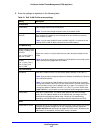
LAN Configuration
102
ProSecure Unified Threat Management (UTM) Appliance
DHCP Server
The default VLAN (VLAN 1) has the DHCP server option enabled by default, allowing the
UTM to assign IP, DNS server, WINS server, and default gateway addresses to all computers
connected to the UTM’s LAN. The assigned default gateway address is the LAN address of
the UTM. IP addresses are assigned to the attached computers from a pool of addresses that
you need to specify. Each pool address is tested before it is assigned to avoid duplicate
addresses on the LAN. When you create a VLAN, the DHCP server option is disabled by
default.
For most applications, the default DHCP server and TCP/IP settings of the UTM are
satisfactory.
The UTM delivers the following settings to any LAN device that requests DHCP:
• An IP address from the range that you have defined
• Subnet mask
• Gateway IP address (the UTM’s LAN IP address)
• Primary DNS server (the UTM’s LAN IP address)
• WINS server (if you entered a WINS server address in the DHCP Setup screen)
• Lease time (the date obtained and the duration of the lease).
DHCP Relay
DHCP relay options allow you to make the UTM a DHCP relay agent for a VLAN. The DHCP
relay agent makes it possible for DHCP broadcast messages to be sent over routers that do
not support forwarding of these types of messages. The DHCP relay agent is therefore the
routing protocol that enables DHCP clients to obtain IP addresses from a DHCP server on a
remote subnet. If you do not configure a DHCP relay agent for a VLAN, its clients can obtain
IP addresses only from a DHCP server that is on the same subnet. To enable clients to obtain
IP addresses from a DHCP server on a remote subnet, you need to configure the DHCP
relay agent on the subnet that contains the remote clients, so that the DHCP relay agent can
relay DHCP broadcast messages to your DHCP server.
DNS Proxy
When the DNS proxy option is enabled for a VLAN, the UTM acts as a proxy for all DNS
requests and communicates with the ISP’s DNS servers (as configured on the WAN ISP
Settings screens). All DHCP clients receive the primary and secondary DNS IP addresses
along with the IP address where the DNS proxy is located (that is, the UTM’s LAN IP
address). When the DNS proxy option is disabled for a VLAN, all DHCP clients receive the
DNS IP addresses of the ISP but without the DNS proxy IP address. A DNS proxy is
particularly useful in auto-rollover mode. For example, if the DNS servers for each WAN
connection are different servers, then a link failure might render the DNS servers
inaccessible. However, when the DNS proxy option is enabled, the DHCP clients can make
requests to the UTM, which, in turn, can send those requests to the DNS servers of the active
WAN connection. However, disable the DNS proxy if you are using a multiple WAN


















